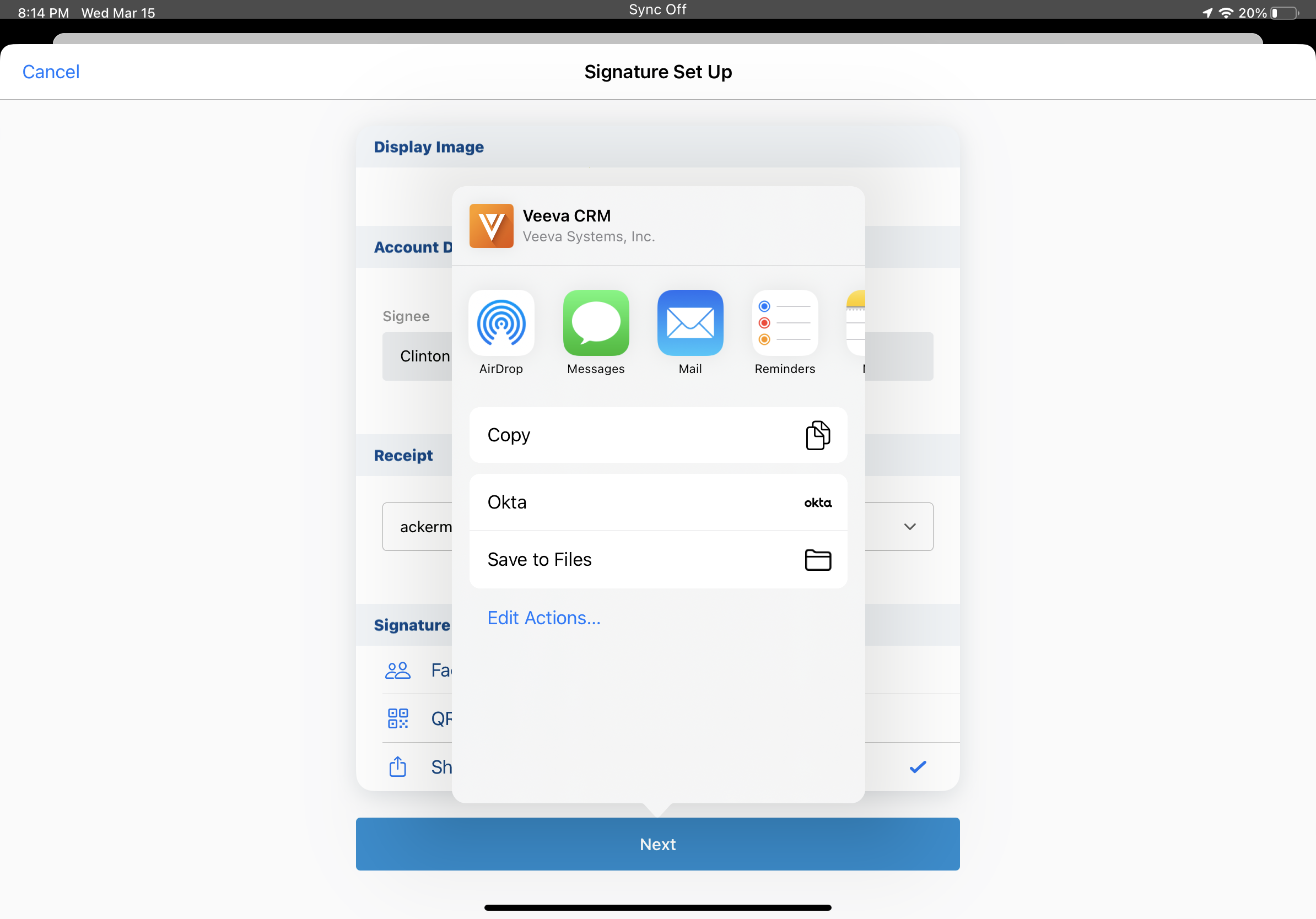Capturing Remote Signatures Asynchronously for BRC Samples (Sign Later)
- CRM Desktop (Windows)
- iPad
- iPhone
Asynchronously capturing signatures for BRC samples provides the flexibility of paper-based sampling with the speed, accuracy, and accountability of remote signature capture, while also letting the HCP sign at their convenience.
For example, an HCP's office lets you know the HCP is out of product samples. To provide the HCP with more product before your next meeting, send an asynchronous signature request to the HCP for BRC sampling. After the HCP signs, review and accept the signature and submit the call report. The BRCs are sent via sample fulfillment vendor.
When asynchronous signature capture is enabled, the existing Share Link remote signature capture functionality is replaced on the CRM Desktop, iPad, and iPhone platforms. On the Browser platform, users cannot capture signatures using Share Link when asynchronous signature capture is enabled.
To capture Share Link signatures immediately, users on the CRM Desktop, iPad, and iPhone platforms can create a signature request using the asynchronous Share Link method, then select the Check for Signatures button without syncing. If the HCP provided a signature, users can review and accept the signature as usual.
Asynchronous remote signature capture is only supported for BRC products on person account calls or unique activities child calls.
Configuring Capturing Remote Signatures Asynchronously for BRC Samples
- Ensure the following configuration is complete for integration users, end users, and admin users:
- Ensure Configuring Sample Requests (BRCs) for Users is enabled
- Ensure Capturing Remote Signatures for Sampling Using Share Link is enabled
Ensure Configuring Enhanced Post-Processing for Integration Users is complete to enable an Engage integration user
- Ensure Displaying Country-Specific Disclaimers is enabled if the disclaimer text should display in available languages
- Ensure Approved Email Receipts for Signature Transactions is enabled if email receipts are desired
-
Ensure Creating Sample Transactions on Save is not enabled. Creating Sample Transactions on Save is not supported in combination with asynchronous remote signature capture.
- Grant the Engage integration users the following permissions:
Object
OLS
Record Types
Fields
FLS
Account R n/a Name Read Signature_Request_vod
CRUD (Modify All Data)
Call_Sample_vod
Name
Read
- Account_vod
- Call2_vod
Call2_Mobile_ID_vod
- Call_Date_vod
- Engage_Last_Modified_Datetime_vod
- Owner
- RecordType
- Request_Canceled_Datetime_vod
- Request_Expired_Date_vod
- Requested_Datetime_vod
- Signature_Accepted_Datetime_vod
- Signature_Captured_Datetime_vod
- Signature_Declined_Datetime_vod
- Signature_Request_UUID_vod
- Status_vod
Edit
- Grant end users the following permissions:
Object
OLS
Record Types
Fields
FLS
Call2_vod
n/a
n/a
Signature_Request_UUID_vod Edit
Sent_Message_vod
CRU
Call_Sample_vod
- Account_vod
- Call_vod
- Capture_Datetime_vod
- Engage_Link_vod
- Mobile_ID_vod
- Sent_From_Platform_vod
- Sent_Via_vod
- Shortened_Engage_Link_vod
- To_vod
- Transaction_Type_vod
- User_vod
- VExternal_Id_vod
Edit
Signature_Request_vod
R
Call_Sample_vod
- Name
- Signature_Request_UUID_vod
- Status_vod
Read
- Grant managers or business admins the following permissions:
Object
OLS
Record Types
Fields
FLS
Account R n/a Name Read Call2_vod
n/a
n/a
Signature_Request_UUID_vod (optional)
Read
Sent_Message_vod
CRU
Call_Sample_vod
- Account_vod
- Call_vod
- Capture_Datetime_vod
- Engage_Link_vod
- Mobile_ID_vod
- Sent_From_Platform_vod
- Sent_Via_vod
- Shortened_Engage_Link_vod
- To_vod
- Transaction_Type_vod
- User_vod
- VExternal_Id_vod
Edit
Signature_Request_vod
R (View All)
n/a
Call2_Mobile_ID_vod
Edit
- Account_vod
- Call2_vod
- Call_Date_vod
- Engage_Last_Modified_Datetime_vod
- Name
- Owner
- RecordType
- Request_Canceled_Datetime_vod
- Request_Expired_Date_vod
- Requested_Datetime_vod
- Signature_Accepted_Datetime_vod
- Signature_Captured_Datetime_vod
- Signature_Declined_Datetime_vod
- Signature_Request_UUID_vod (optional)
- Status_vod
Read
- Place the Signature_Request_UUID_vod field on admins’ Call2_vod page layouts for troubleshooting or reporting purposes (optional).
When unique activities are enabled, the Signature_Request_UUID_vod must be in the Unique_Person_Fields_vod section or in an attendee-specific control section. For more information, see Defining Child Only Fields.
- Assign the Signature_Request_vod tab to admins (optional). This tab enables admins to track signature request status.
Ensure fields on the Signature_Request_vod page layout are marked as read-only. Do not edit Signature_Request_vod records directly. Signature_Request_vod records should only be updated through the Engage integration or Veeva triggers.
- Ensure VMOCs are enabled for the following objects:
- Engage_Link_Settings_vod
- Sent_Message_vod - for the CRM Desktop (Windows) platform, use WinModern platform VMOCs
- Signature_Request_vod
- Remove the WHERE clause for the Engage_Link_Setting_vod VMOCs.
Modifying the Signature Request Expiration Period
By default, pending signature requests remain active for seven days. To change the number of days a signature request link should remain active, edit the value in the Call_Sign_Request_Expiry_Period_vod Engage Setting. Use an integer between one and fifteen.
When users create a signature request, an expiration date for the signature request is automatically calculated. The expiration date is the number of days in the Call_Sign_Request_Expiry_Period_vod Engage Setting, plus the current date in Coordinated Universal Time (UTC), minus one day. For example, if Sarah Jones records a call at 5:00 PM on March 31 in the U.S. Pacific Time zone (12:00 AM on April 1 in UTC) and the Call_Sign_Request_Expiry_Period_vod Engage Setting is set to 1, the signature request expires on April 1.
To ensure HCPs have adequate time to submit their signatures, requests expire in a batch job at 12 AM or 12 PM (UTC) on the day after the expiration date. After a batch job runs, up to 12 additional hours may pass before the next batch of signatures expires. The minimum time a signature request remains active is 24 hours.
Configuring Custom Sharing Options for iOS Users
By default, users on the iPad and iPhone platforms select from standard iOS sharing options when sharing asynchronous BRC signature links. To control the number and order of sharing options, a custom sharing modal is available. Admins define which sharing options are available to end users and the order in which they display.
If the Engage Chat sharing option is enabled, Engage Chat always displays first in the custom sharing modal.
For CRM Desktop (Windows) users, only the Copy Link and QR Code® options are available after selecting the Share Link Method. The sharing modal on CRM Desktop (Windows) respects the ENGAGE_LINK_APPS;;EngageLink Veeva Message, but only the CopyURL method is supported, and the modal is not configurable through the Call_Sign_Share_Sheet_vod Engage Link Setting.
To enable custom sharing options for users on the iPad and iPhone platforms:
- Populate the Call_Sign_Share_Sheet_vod Engage Link Setting with the number 1.
- Edit the list in the ENGAGE_LINK_APPS;;EngageLink Veeva Message to include the appropriate options, in the desired order. The following options are available for asynchronous BRC signature capture:
Sharing Option
Supported Platforms
CopyURL
This also enables QR code functionality.
- CRM Desktop (Windows)
- iPad
- iPhone
EngageConnect
EngageConnect cannot be configured with EngageChat.
- iPad
- iPhone
EngageChat
EngageChat cannot be configured with EngageConnect. Additionally, the Engage tab must be configured to use Engage Chat.
- iPad
- iPhone
LINE
- iPad
- iPhone
Messages
- iPad
- iPhone
WhatsApp
- iPhone
Editing the list in the ENGAGE_LINK_APPS;;EngageLink Veeva Message affects the sharing options for the following features, which also rely on the ENGAGE_LINK_APPS;;EngageLink Veeva Message:
- Capturing Remote Signatures for Acknowledgement of Content
- Scheduling and Starting Microsoft Teams Meetings
- Sending Engage Connection Invites to HCPs
- Sharing CLM Content via Web Link or QR Code®
- Sharing Websites via Web Link or QR Code®
- Presenting CLM Content Remotely
The ENGAGE_LINK_ACCOUNT_SELECTION_vod Veeva Setting is not respected for asynchronous BRC signature links, since the HCP signing for BRCs must be the account selected on the call report.
Configuring Call Submission with Pending Signature Requests
For increased flexibility in call reporting, users can be allowed to submit calls while asynchronous BRC signature requests are pending. Users do not need to review and accept signatures; HCP signatures are automatically accepted on planned, saved, and submitted calls.
Validation Disclaimer
This enhancement is released without validation. This functionality requires enablement and does not affect other Veeva CRM functionality. This functionality was extensively tested by our QA team during the development and release process and will go through validation at a later date.
To enable call submission with pending signature requests:
- Ensure end users have Edit FLS to the First_Submitted_Datetime_vod field on the Call2_vod object. For more on this field, see Submitting a Call Report.
- Grant end users and integration users Edit FLS to the Override_Lock_vod field on the Call2_vod and Call2_Sample__vod objects, to enable submission of pre-existing calls with pending signature requests. Alternatively, allow all signature requests to expire before enabling this functionality.
- Grant integration users Read OLS to the Account_Authorization_vod object, if Sampling with Mid-level Practitioners is enabled. This is required even in states which do not require collaborative relationships for mid-level physicians.
- Ensure integration users are granted View Setup and Configuration permission, if Approved Email Receipts for Signature Transactions are enabled.
- Ensure the values in the Sample_Management_Product_Types_vod Veeva Setting are identical for the end user and the integration user. For example, if BRC is listed in the setting for the end user, it must also be listed for the integration user, and vice versa. For more information on the setting, see Managing Non-Sample Products.
- Set the CALL_SUBMIT_PENDING_SIG_REQ_vod Engage Setting to 1.
- Grant admins Read FLS to the Call_Signature_Status_vod field on the Call2_vod object for reporting and visibility (optional).
This functionality cannot be used in combination with sample limits on Promotional Material, Reprint, or Custom product types.
Ensure the length of the Disclaimer_vod fields on the Call2_vod and Sample_Order_Transaction_vod objects match and are greater than or equal to the value in the DISCLAIMER;;CallReport Veeva Message. If the value in the DISCLAIMER;;CallReport Veeva Message exceeds the Disclaimer_vod field's character limit on the Call2_vod or Sample_Order_Transaction_vod objects, a validation error occurs when users attempt to capture signatures and signature records are not updated. By default, the limit is 1000 characters. For information on increasing disclaimer length, see Modifying the Signature Disclaimer.
Signature request behavior is based on the CALL_SUBMIT_PENDING_SIG_REQ_vod Engage Setting’s status at the time the signature request is created. When this functionality is first enabled, users must review and accept any pre-existing signature requests. If the CALL_SUBMIT_PENDING_SIG_REQ_vod Engage Setting is later enabled or disabled, existing signature requests are handled based on the status of the setting at the time the signature request was created.
When this functionality is enabled, Veeva recommends sample fulfillment vendors and other downstream systems identify new BRC signatures based on Sample_Order_Transction_vod record creation. If a signature request expires on a submitted call or if the user cancels a signature request on a submitted call, the call sample status in Veeva CRM is updated to Canceled.
Using Remote Signature Capture Asynchronously for BRC Samples
To capture a remote signature asynchronously, CRM users:
- Create a call report with BRC samples. If any other sample or promotional product is on the call report, the Share Link signature capture option is not available.
Signature capture must be required in order to use asynchronous remote signature capture. Asynchronous remote signature capture is not supported on calls where signature capture is optional or disabled—for example, it is not supported on calls where the --nslns or --npdma section signals are in use.
- Select the Sign button.
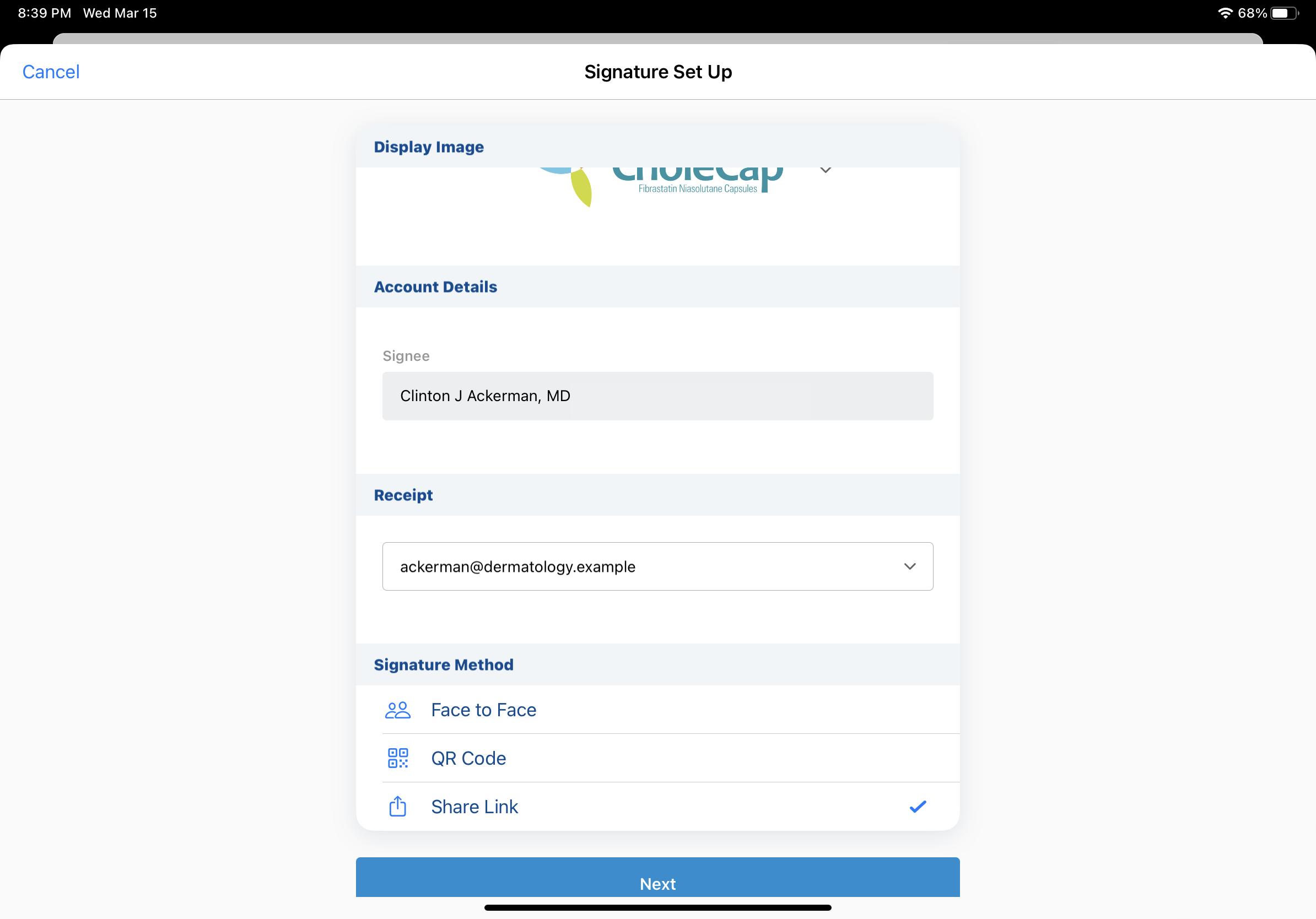
- Select the disclaimer text language. This step is only available if Displaying Country-Specific Disclaimers is enabled.
- Select the email address the receipt should be sent to using the Receipt picklist, if the HCP wants to receive a receipt (optional). This step is only available if Approved Email Receipts for Signature Transactions is enabled.
- Select Share Link for the Signature Method.
- Select Next.
- Select the appropriate application to share the generated link with the HCP. If an acceptable application is not available, select Copy Link to copy the link to the device’s clipboard.
On the CRM Desktop (Windows) platform, users can share links using the Copy Link method or QR Code.
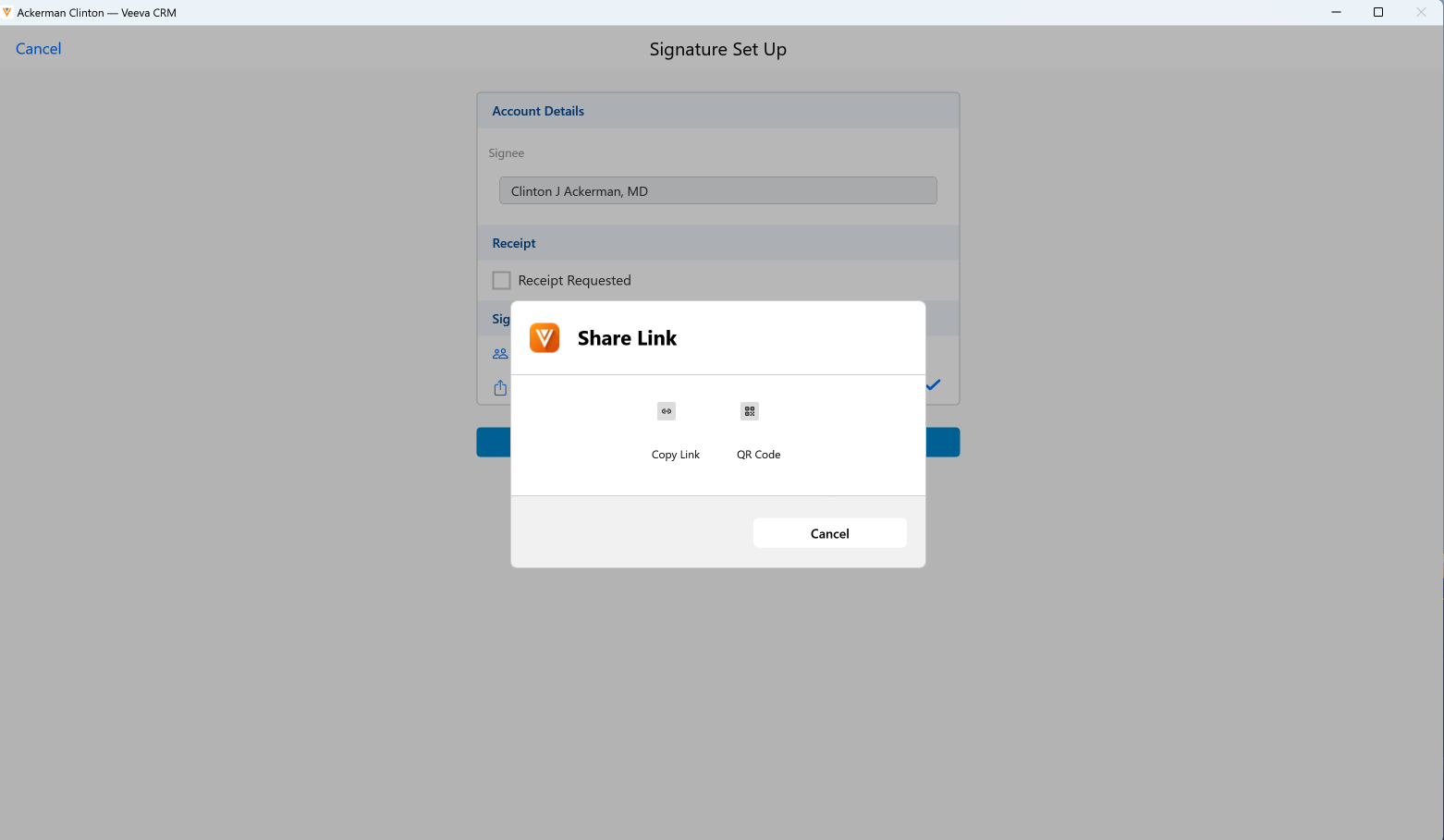
Once users share the link, the call report displays. Users do not need to remain in the Veeva CRM application while waiting to capture the signature.
Using Custom Sharing Options
When the Call_Sign_Share_Sheet_vod Engage Link Setting is enabled, iPad and iPhone users select from custom sharing options defined in the ENGAGE_LINK_APPS;;EngageLink Veeva Message, instead of selecting from iOS standard sharing options.

The following custom sharing options are available:
- Copy Link
- QR Code
- Engage Chat
- Engage Connect
- LINE
- Message
When users select a sharing option, a Sent_Message_vod record is created with the following information:
|
Field |
Value |
|---|---|
|
Account_vod |
The account requesting samples |
|
Call_vod |
Lookup to the associated Call2_vod record. For unique activity group calls, this is the attendee child call for the account. |
|
Capture_Datetime_vod |
The datetime at which the user selected the sharing option in the link sharing modal |
|
Engage_Link_vod |
The signature request URL |
|
Mobile_ID_vod |
A system generated ID |
|
RecordTypeId |
Call_Sample_vod |
|
Sent_From_Platform_vod |
The platform from which the link was shared:
|
|
Sent_Via_vod |
The app used to share the link:
|
|
Shortened_Engage_Link_vod |
The shortened signature request URL |
|
To_vod |
The account phone number or ID of the app where the link is shared. This field is only populated if an account phone number or app ID is available when the user selects a sharing option. |
|
Transaction_Type_vod |
Call_Sign_Async_vod |
|
User_vod |
Lookup to the user who sent the message |
|
VExternal_Id_vod |
The unique identifier for the shortened URL |
Viewing Pending Signature Requests
A yellow banner displays on the Sample and Promotional Items section of the call report to highlight pending signature requests. To check whether the HCP has submitted a signature, select the Check for Signature link from the blue banner.
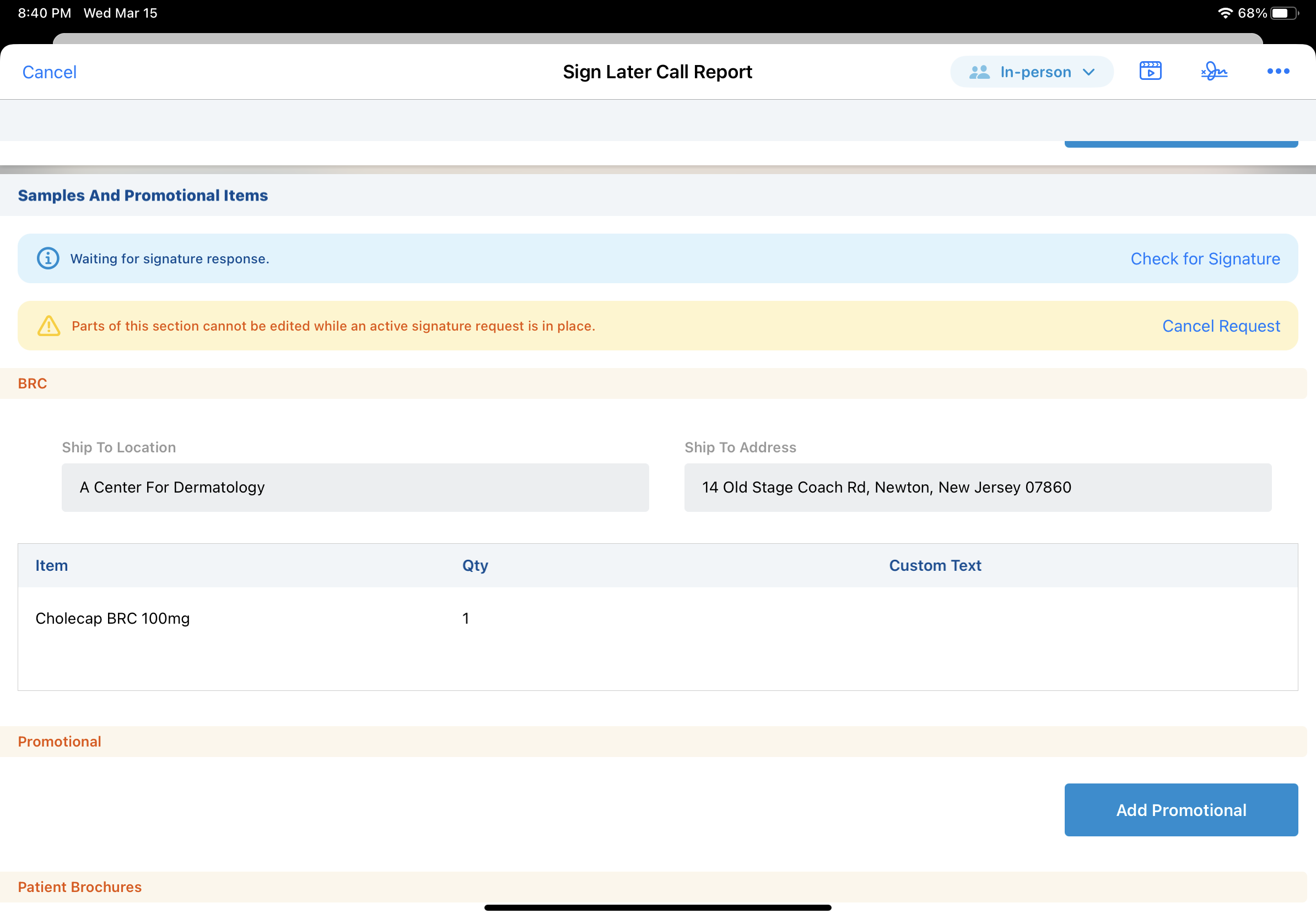
For call reports with pending signature requests, users cannot:
- Submit the call report, unless the CALL_SUBMIT_PENDING_SIG_REQ_vod Engage Setting is enabled
- Delete the call report
- Capture another signature for the same call using a different method—for example, QR Code® signature request
- Edit fields related to sampling and BRCs, or fields placed in the sample and promotional items section. When there is a pending signature request, fields related to signature capture and sampling are read-only.
Users cannot delete unique activities group calls where one or more of the child calls have a pending request. They also cannot submit unique activities group calls where one or more of the child calls have a pending request, unless the CALL_SUBMIT_PENDING_SIG_REQ_vod Engage Setting is enabled. Signature request status displays in the attendee section for each attendee.
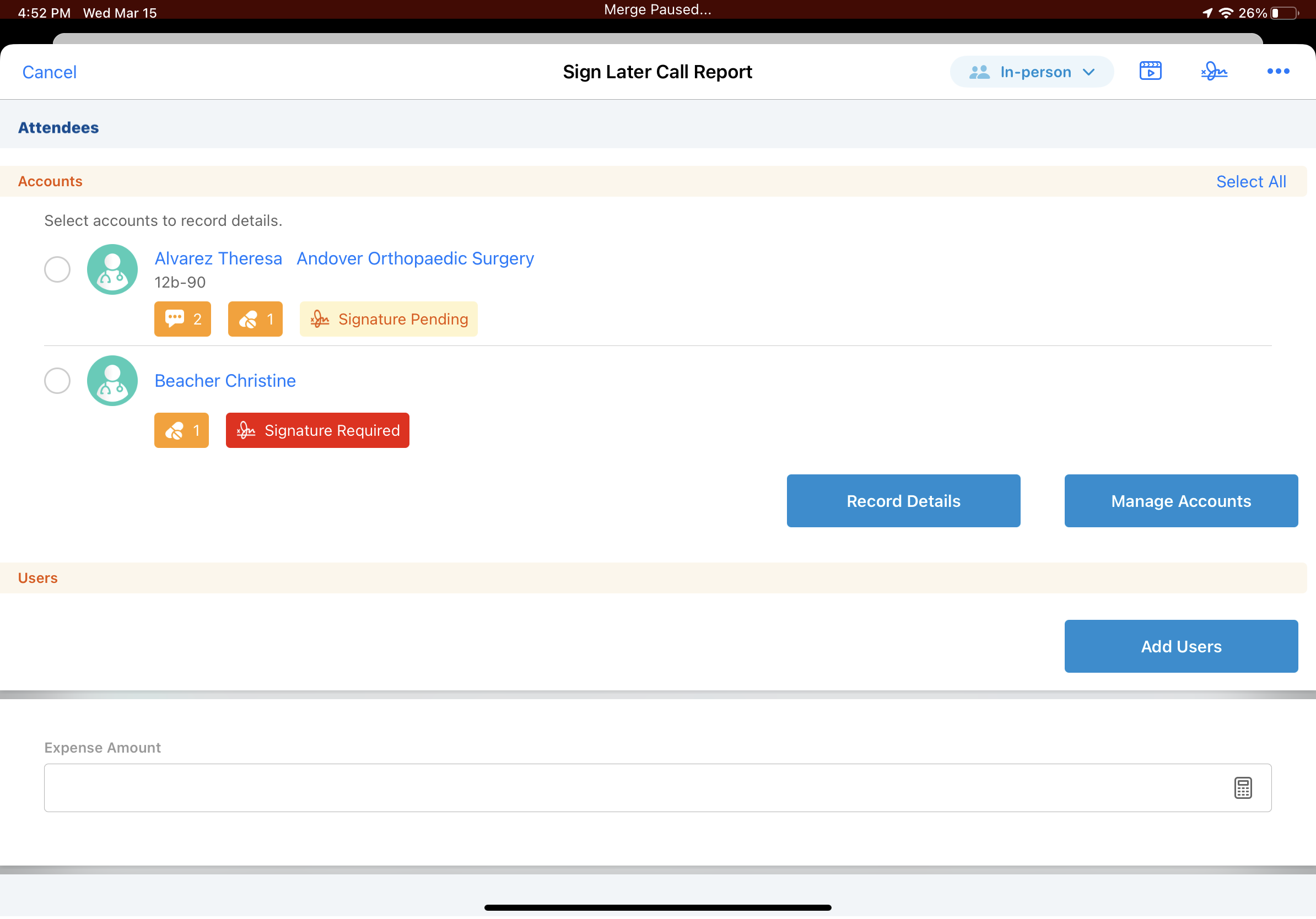
When swapping signees on the call report, users cannot swap signees to accounts with signatures pending or signatures ready for review. If users select an account with an outstanding signature request, an error displays and users are prevented from swapping the signee to the account.
Canceling Pending Signature Requests
Users can cancel pending signature requests until the HCP provides a signature. To cancel a pending request, select Cancel Request from the yellow signature request banner and confirm the cancellation.

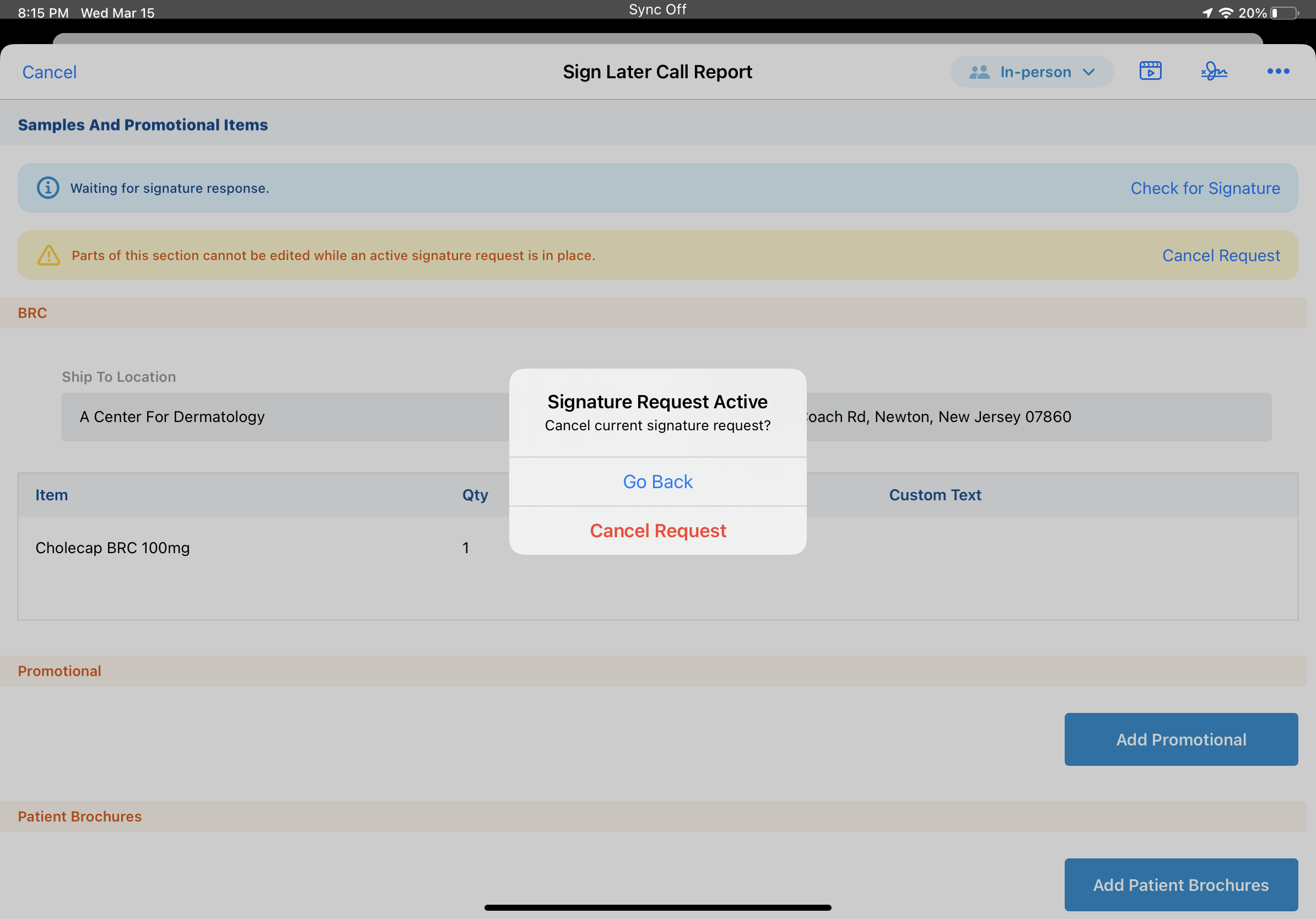
Submitting Calls with Pending Signature Requests
When the CALL_SUBMIT_PENDING_SIG_REQ_vod Engage Setting is enabled, users can submit calls with pending signature requests. These requests remain active until the Call_Sign_Request_Expiry_Period_vod expires, indicated by a banner on the submitted call, or unless the user cancels the signature request.
If the signature request expires before the HCP submits a signature, a message displays in the sample section of the call report.

When HCPs submit their signatures for planned, saved, or submitted calls, the signature is automatically accepted. In addition:
- An Approved Email receipt is sent to the HCP, if selected on the signature request screen
- An email notification is sent to the end user who created the signature request
- Sample_Order_Transaction_vod records are created for the BRCs
- The selected BRCs are subtracted from the user’s sample inventory
- Sample_Limit_Transaction_vod records are created and sample limits are recalculated according to the disbursement, if enabled
If the signature request is cancelled before the HCP signs, the Delivery_Status_vod field on Call2_Sample_vod records for the call is set to Cancelled_vod.
Reporting on Signature Request Status
To enable admins to view and report on signature request status, the Call_Signature_Status_vod field on the Call2_vod record is updated with the status of the signature request linked to the call changes.
Providing Remote Signatures Asynchronously
HCPs receive the remote signature request link through the application the end user selected. Selecting the link opens an internet browser, where the signer can review the BRC details and submit their signature. The Signature_Captured_Datetime_vod field on the Signature_Request_vod object is set to the date and time when the HCP selects the Accept button on the signature capture screen.
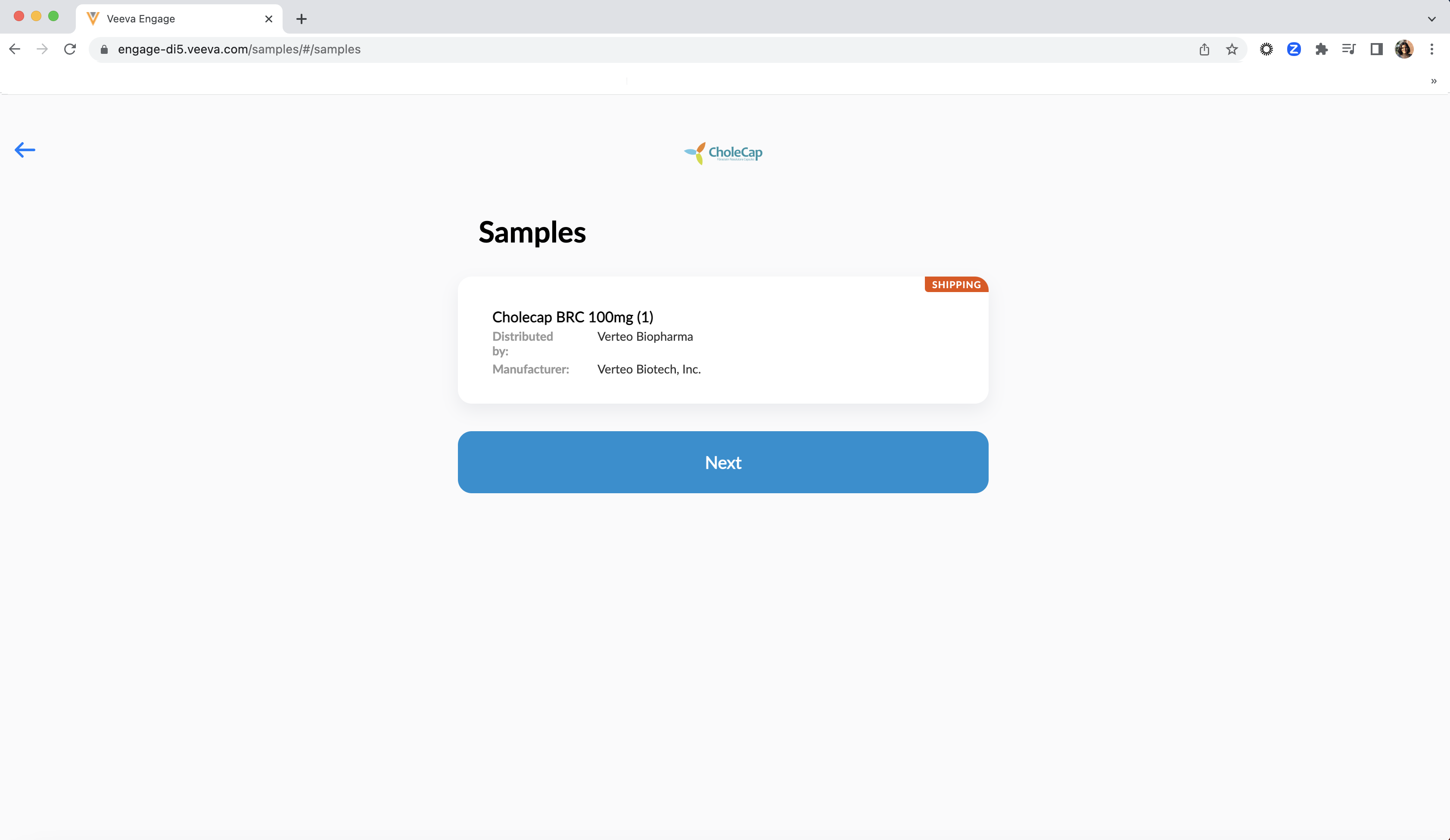
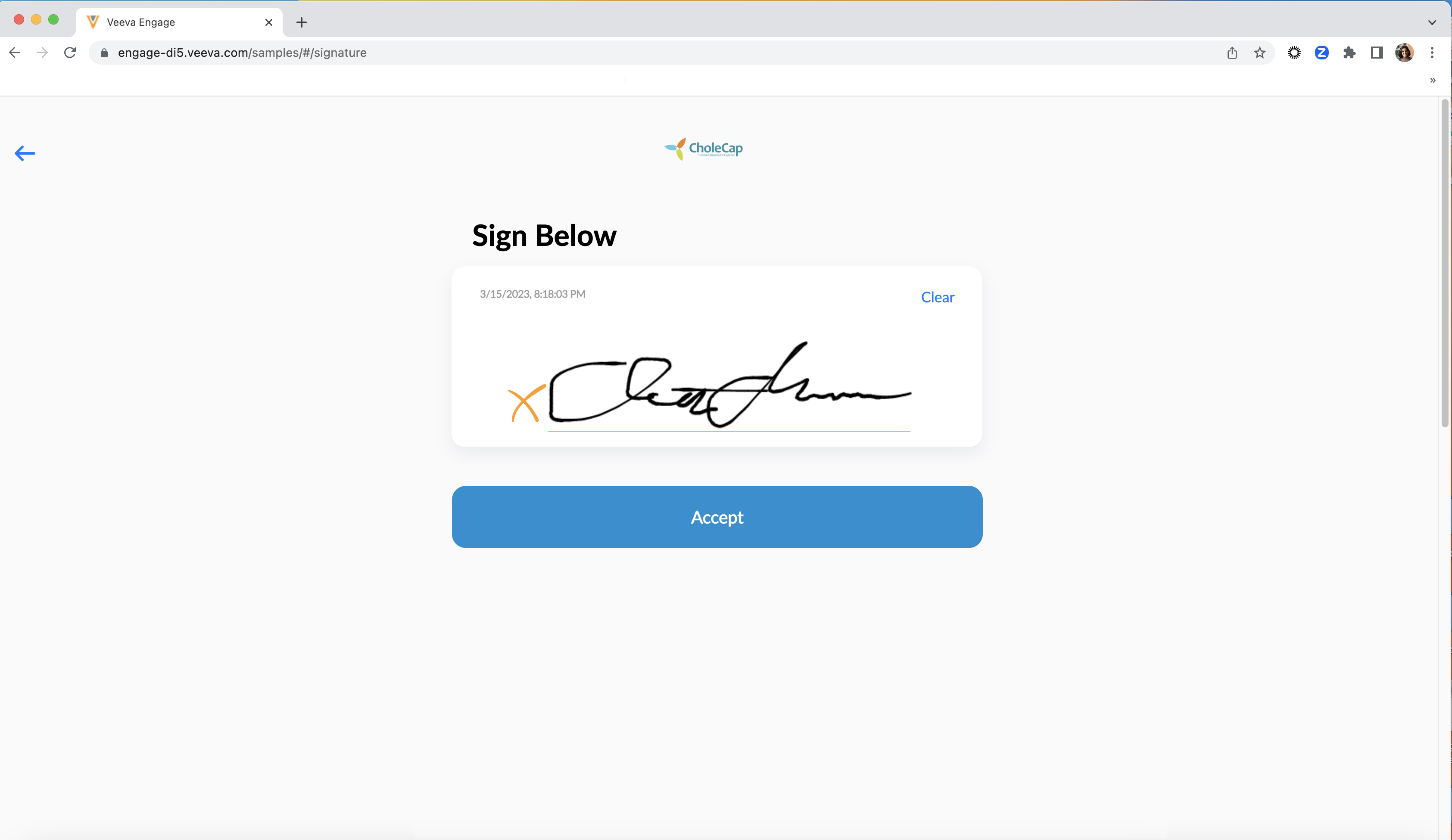
Reviewing HCP Signatures
When HCPs submit their signatures, users receive an email that notifying them a signature is ready for review. There is no time limit for accepting a signature. Users can accept the signature at any time after the HCP provides it.
To review and accept HCP signatures:
- Navigate to the call report.

- Select Review Signature. The signature review screen displays.
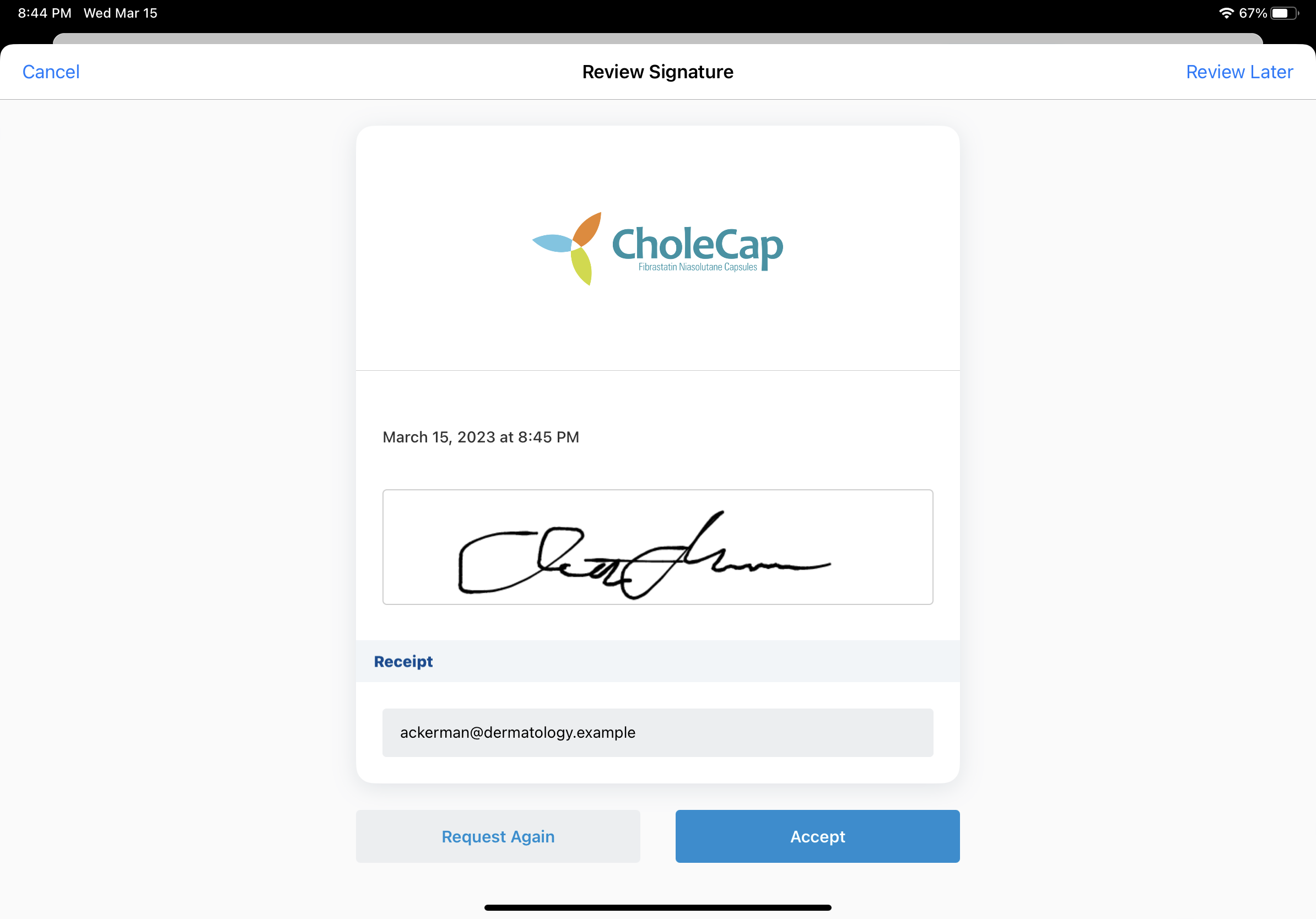
- Select Accept.
To ensure accurate, compliant signature capture data, the following occurs when a signature is accepted:
- The Signature_Request_vod record is updated to a Signature Accepted status
- The Signature Accepted Datetime field is populated with the current date and time
- Signature capture information is locked on the Call2_vod record
- The Signature_Captured_Share_Link_vod field is stamped on Call2_vod, Sample_Order_Transaction_vod, and Sample_Order_Transaction_Audit_vod records. For more information on Signature_Captured_Share_Link_vod, see Reviewing Remote Signatures.
For asynchronous signature capture, sample and product limits are recalculated when users accept the HCP’s signature. When Creating Sample Transactions on Sign Save is enabled and users save the call report, the lot quantity, sample and product limits, and sample transaction records are only updated if there is a captured signature on the call report.
If users do not want to accept the submitted signature, the following options are available:
- Cancel - Cancels the submitted signature. The HCP’s signature is not saved to the call report. To capture the HCP’s signature, the user must generate a new signature request link. For example, Dr. Ackerman contacts Sarah Jones after he submits his signature and asks her to send fewer Cholecap BRCs than he signed for. Sarah cancels the submitted signature and creates a new signature request with Dr. Ackerman’s preferred quantity of BRCs.
- Review Later - Return to the call report without canceling or accepting the signature. The HCP signature remains available for the user to review and accept.
- Request Again - Generates a new signature request link for the user to share
Platform Specific Details for CRM Desktop (Windows)
- The ENGAGE_LINK_APPS_vod Engage Setting, which controls the available sharing options and their order, is respected. However, only the CopyURL value is currently supported for the ENGAGE_LINK_APPS_vod Engage Setting on CRM Desktop (Windows).
- Outside of an Engage meeting, only asynchronous Share Link and asynchronous QR Code® signature capture methods are supported on the CRM Desktop (Windows) platform. To share a signature request using QR Code®, CRM Desktop (Windows) users must be configured for asynchronous signature capture.



